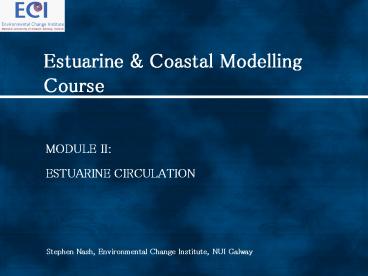Estuarine PowerPoint PPT Presentation
1 / 35
Title: Estuarine
1
Estuarine Coastal Modelling Course
MODULE II ESTUARINE CIRCULATION
Stephen Nash, Environmental Change Institute, NUI
Galway
2
ESTUARINE CIRCULATION CONTENT- I Tidal
Currents II Bathymetry III Coriolis
force IV Meteorological Effects V Freshwater
Inflows VI Density VII Advection, Diffusion and
Dispersion
3
I TIDAL CURRENTS
4
I TIDAL CURRENTS Currents
- May be tidal or non-tidal
- Tidal due to tidal oscillations
- Non-tidal
- Bathymetry
- Coriolis force
- Wind
- Rivers
- Density
- Tidal non-tidal currents hydrodynamic
circulation
5
I TIDAL CURRENTS Tidal Wave
- Shallow-water wave
- Tidal pattern
- Low tide
- Flood tide
- High tide
- Ebb tide
- Current varies with tide
6
I TIDAL CURRENTS Open Sea Tidal Currents
- Progressive wave
- Current directly proportional to
- tidal range
- Currents typically weak
- 5 10 cm/s
7
I TIDAL CURRENTS Estuarine Tidal Currents
- Coastline shape affects wave behaviour
- progressive wave ? standing wave
- Elements of both waveforms
- Tidal reversal at high/low water
- No flow at high/low (slack) water
- Max. currents at mid-tide
- Lag in tides along estuary
8
I TIDAL CURRENTS Tidal Wave Distortion
- Caused by
- Channel shape
- Bathymetry
- Extreme distortion
- ? Tidal bores
9
I TIDAL CURRENTS Current Velocity
- Vector quantity ? speed and direction
- Temporal variation
- Spatial variation flow field
- Variation with depth
10
I TIDAL CURRENTS Current Velocity Display
- Time-series
- Current ellipse / current rose (temporal
variation) - Stick plot
- Vector snapshot (spatial variation)
- Identification of hydrodynamic features gyres,
jets, etc.
11
I TIDAL CURRENTS Current Velocity Display
- As a time Series
- Plots the variation of current magnitude and
direction with time - Can be displayed as total magnitude or as ebb
(negative) and flood (positive)
12
I TIDAL CURRENTS Current Velocity Display
- As a Current Ellipse (or Rotary Current)
- Current velocities at different hrs represented
by vectors with common origin - Open Sea elliptical
- Estuaries predominantly in two directions (ebb
and flood)
13
I TIDAL CURRENTS Current Velocity Display
- As a Vector Stick Plot
- Hourly current vectors plotted on a horizontal
time axis
14
I TIDAL CURRENTS Current Velocity Display
- As a Vector Snapshot
- Plot of current vectors at an instant in time ?
flow field
15
I TIDAL CURRENTS Residual Currents
- Tidal effects only
- Flood transport ebb transport ? zero net
transport - Interaction of tides with other forces
bathymetry - Flood transport ? ebb transport ? some net
transport - Residual current algebraic sum of velocity over
a tidal cycle - Residual circulation IS estuarine circulation
16
I TIDAL CURRENTS Residual Currents
- Residual current vector snapshots
17
II BATHYMETRY
18
II BATHYMETRY Definition
- Bathymetry is... underwater topography
- 2D, 3D
19
II BATHYMETRY Significance
- Interaction with tides ? current velocities
- Bathymetric steering
- Tidal pumping
- Tidal trapping
20
II BATHYMETRY Jets and Gyres
- Phenomena caused by interaction between
bathymetry, tidal wave and sometimes wind - Jet
- A high velocity fluid stream caused when water is
forced through a narrow/constricted opening into
a wider estuarine basin - Gyre
- Circular movements of water about a particular
point (the eye), may be clockwise or
anticlockwise - Current velocity at/near the eye is close to zero
- Usually accompany jet formations
21
II BATHYMETRY
22
III CORIOLIS FORCE
23
III CORIOLIS FORCE
- Apparent force to allow for earths rotation
- Northern hemisphere ? flows deflected to right
- Southern hemisphere ? flows deflected to left
- Dependent on latitude
- Importance ? Rossby Number, RO
24
IV METEOROLOGICAL EFFECTS
25
IV METEOROLOGICAL EFFECTS Wind
- Impact on Currents
- Wave generation
- Large waves can affect circulation patterns
- Promotes vertical mixing
- Surface currents
- Drag force on water surface ? acceleration of
particles - Fetch, wind velocity, duration
- Wind effect ? water depth, stratification
- Timescales
26
IV METEOROLOGICAL EFFECTS Wind
- Surge/swell sea level fluctuations caused by
strong winds - High winds cause water to pile-up
- Much higher tides than normal
- Devastating effects when combined with high
spring tides - Atmospheric pressure
- Low pressure ? higher sea level
- High pressure ? lower sea level
- Combine with strong winds
- Meteorological tides
27
IV METEOROLOGICAL EFFECTS Storm Surge
Hurricane Katrina On the Gulf Coast
28
V FRESHWATER INFLOWS
29
V FRESHWATER INFLOWS
- Significant impact on hydrodynamics mixing
- Stratification and associated circulation
patterns - Mixing effects from variations in flow
- Outfall location
- Momentum effects on local currents
- Duration of flood and ebb currents
30
VI WATER DENSITY
31
VI WATER DENSITY Density
- Pure water ? 1,000 kg/m3
- Ocean water at sea surface ? 1,027 kg/m3
- Factors Affecting Density
- Temperature temp ? ? density ?
- Salinity salinity ? ? density ?
- Temp has greater effect than salinity
- Thermohaline circulation
32
VII ADVECTION, DIFFUSION AND DISPERSION
33
VII ADVECTION, DIFFUSION AND DISPERSION
- Advection
- Transport due to bulk movement of water
- Moves matter from one position to another
- Diffusion
- Transport due to random movement of water
- Molecular diffusion from Brownian motion of
water particles - Turbulent diffusion from eddies
- Migration of a solute due to concentration
gradients
- Advection
- Mixing due to non-uniformities in velocities
34
ESTUARINE CIRCULATION CONTENT- I Tidal
Currents II Bathymetry III Coriolis
force IV Meteorological Effects V Freshwater
Inflows VI Density VII Advection, Diffusion and
Dispersion
35
Estuarine Coastal Modelling Course
MODULE II ESTUARINE CIRCULATION
Stephen Nash, Environmental Change Institute, NUI
Galway

